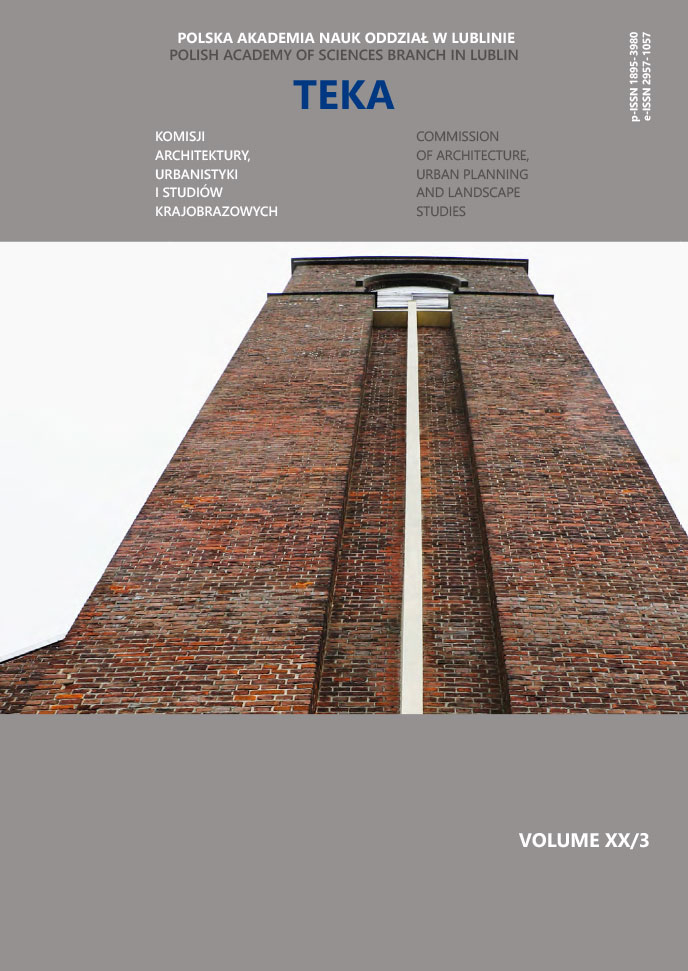The Place of the Lost Architectural and Urban Planning Heritage in the Modern Environment of Ukrainian Cities
Article Sidebar
Open full text
Issue Vol. 20 No. 3 (2024)
-
Urban Phenomenon of Lviv. Identification and Regeneration of Valuable Urban Complexes
Mykola Bevz7-23
-
The Influence of the Material-structural Characteristics of Travertine, Limestone and Alabaster on the Features of Their Use in the Construction of the Assumption Cathedral in Princely Halych
Ulyana Bornyak, Viktor Melnyk24-31
-
The Role of the Basilian Monasteries in the Formation of the Sacred Space of the Cities and Villages of Ukraine
Lesia Chen32-39
-
Copying Geological Relics in the Process of Preservation and Restoration of Architectural Monuments
Оlena Stasyuk, Tetiana Dziubanovska40-44
-
Return of the Authentic Artistic Decor of the Assembly Hall of the Main Building of the Lviv Polytechnic University
Mykola Bevz, Serhii Hetmanchuk, Myron Demkiv45-53
-
The Place of the Lost Architectural and Urban Planning Heritage in the Modern Environment of Ukrainian Cities
Volodymyr Gaidar54-61
-
Analiza stanu zachowania obiektów sakralnych XX-lecia międzywojennego na Lubelszczyźnie
Weronika Kendzierawska, Maciej Trochonowicz62-70
Archives
-
Vol. 20 No. 3
2024-12-27 7
-
Vol. 20 No. 2
2024-12-27 7
-
Vol. 20 No. 1
2024-12-27 8
-
Vol. 19 No. 2
2023-12-29 11
-
Vol. 19 No. 1
2023-12-19 13
-
Vol. 18 No. 4
2022-12-30 5
-
Vol. 18 No. 3
2022-12-27 5
-
Vol. 18 No. 2
2022-12-27 5
-
Vol. 18 No. 1
2022-12-27 4
-
Vol. 17 No. 4
2021-12-30 11
-
Vol. 17 No. 3
2021-12-30 9
-
Vol. 17 No. 2
2021-12-30 8
-
Vol. 17 No. 1
2021-12-30 8
-
Vol. 16 No. 4
2020-12-30 11
-
Vol. 16 No. 3
2020-09-30 10
-
Vol. 16 No. 2
2020-06-30 11
-
Vol. 16 No. 1
2020-03-31 10
Main Article Content
DOI
Authors
Abstract
The study examines the problem of presenting the lost architectural and urban planning heritage in the modern environment of Ukrainian cities. Currently, in our historical cities, we have a significant number of lost valuable architectural structures and complexes that are not known to society. These are unique objects that had historical, urban planning, scientific and restoration value, their place and role in the volume-spatial structure of cities was often key. Today, these objects are critically lacking for the formation of a coherent picture of the perception of the historical environment.
The historical environment today is not perceived as it was originally intended by the creators of cities. For the most part, it was the lost components of historical cities that contained significant national, cultural-artistic, architectural-historical value. Such objects as castles, palaces, fortresses, sacred, public, recreational, residential complexes formed national identity and were material symbols of the entire Ukrainian people.
On the example of a lost sacred building – the Greek Catholic church of the 17th century. in the historical city of Ivano-Frankivsk, a variant of the symbolic identification of a lost valuable object is presented. The developed and implemented project “Square with a memorial sign in honor of the first Ukrainian Church of the Holy Resurrection (XVII century) in Ivano-Frankivsk” is a composition of volumetric and spatial symbolic identification of the Ukrainian church, which helps to form a complete picture perception of the city’s architectural and urban planning heritage. The object is located in a formed historical environment, successfully complements it and symbolizes the Ukrainian heritage of the past.
Keywords:
References
Haydar V. 2024. Problems of identification and marking of architectural and urban planning heritage in the modern urban environment. KNUBA architectural bulletin. No. 29. P. 40−51. DOI: https://doi.org/10.32347/2519-8661.2024.29.40-51
V. Hrabovetskyi 1999. History of Ivano-Frankivsk, Part 1, Nova Zorya. Ivano-Frankivsk, p. 301.
Zhovkva O. 2019. Architectural heritage. Separate issues of cultural heritage protection. Urban planning and territorial planning. Vol. 69. P. 133−146.
Kondel-Perminova N. 2008. Integration of architectural monuments and urban planning in the modern socio-cultural context. Modern problems of research, restoration and preservation of cultural heritage: collection. of science pr. IPSM AMU, Vol. 5, Kyiv, pp. 94−110.
Kondel-Perminova N. 2009. Preservation of the architectural and urban heritage of Ukraine in the context of urban development. Modern problems of research, restoration and preservation of cultural heritage. Vol. 6. P. 92−116.
Methodology of preservation and regeneration of the historical urban environment. 2022. Col. monograph. ed. Mykola Bevz. Lviv Polytechnic National University, ICCROM, ICOMOS, Lviv-Kyiv – print: “Rastr-7”. p. 378.
Mogytych I. 1996. Problems of preservation of traditional architectural heritage, Visnyk Ukrzakhidproektrestavratsiya, Lviv, No. 4, pp. 17−18.
Polek V. 1994. On the Squares and Streets of Ivano-Frankivsk, “Light and Shadow”, Lviv, p. 90.
Polivach K. 2012. Cultural heritage and its influence on the development of the regions of Ukraine. K.: Institute of Geography of the National Academy of Sciences of Ukraine. p. 208.
Prybyeha L. 2004. Historical environment as a monument protection category, Ukrainian Academy of Arts. Vol. 11, pp. 177−185.
Timofienko V. 2004. Protection of cultural heritage and problems of development of the centers of modern cities, Art Culture. Actual problems. Vol. 1, Mus. Ukraine, Kyiv, pp. 91−106.
Ulrich von Werdum. 1983. Diary, October, No. 10, p. 100. DOI: https://doi.org/10.1017/S0074180900033131
Fedunkiv Z. 2014. Stanislaviv on ancient maps and plans. My city. Lileya-NV. p. 176.
Barącz S. 1858. Pamiętnik miasta Stanisławowa. Lwów. s. 191.
Krawcow S. 1981. Stanisławów w XVII – XVIII w. Układ przestrzenny i jego symbolika, Kwartalnik architektury urbanistyki. P. 3−19.
Szarlowski A. 1887. Stanisławów i powiat Stanisławowski. Stanisławów. P. 204−205.
Article Details
Abstract views: 191



